/cdn.vox-cdn.com/uploads/chorus_image/image/66094266/82_EatingLickingDrinking_HermanEckelmann_NAIC.0.0.0.0.jpg)
Filed under:

The 116 photos NASA picked to explain our world to aliens
Share this story.
- Share this on Facebook
- Share this on Twitter
- Share this on Reddit
- Share All sharing options
Share All sharing options for: The 116 photos NASA picked to explain our world to aliens
If any intelligent life in our galaxy intercepts the Voyager spacecraft, if they evolved the sense of vision, and if they can decode the instructions provided, these 116 images are all they will know about our species and our planet, which by then could be long gone:
When Voyager 1 and Voyager 2 launched into space in 1977, their mission was to explore the outer solar system, and over the following decade, they did so admirably.
With an 8-track tape memory system and onboard computers that are thousands of times weaker than the phone in your pocket, the two spacecraft sent back an immense amount of imagery and information about the four gas giants, Jupiter, Saturn, Uranus, and Neptune.
But NASA knew that after the planetary tour was complete, the Voyagers would remain on a trajectory toward interstellar space, having gained enough velocity from Jupiter's gravity to eventually escape the grasp of the sun. Since they will orbit the Milky Way for the foreseeable future, the Voyagers should carry a message from their maker, NASA scientists decided.
The Voyager team tapped famous astronomer and science popularizer Carl Sagan to compose that message. Sagan's committee chose a copper phonograph LP as their medium, and over the course of six weeks they produced the "Golden Record": a collection of sounds and images that will probably outlast all human artifacts on Earth.
How would aliens know what to do with the Golden Record?
The records are mounted on the outside of Voyager 1 and Voyager 2 and protected by an aluminum case. Etched on the cover of that case are symbols explaining how to decode the record. Put yourself in an extraterrestrial's shoes and try to guess what the etchings seek to communicate. Stumped? Hover over or click on the yellow circles for the intended meaning of these interstellar brain teasers:

What else is on the Golden Record?
Any aliens who come across the Golden Record are in for a treat. It contains:
- 116 images encoded in analog form depicting scientific knowledge, human anatomy, human endeavors, and the terrestrial environment. (These images appear in color in the video above, but on the record, all but 20 are black and white.)
- Spoken greetings in more than 50 languages.
- A compilation of sounds from Earth.
- Nearly 90 minutes of music from around the world. Notably missing are the Beatles, who reportedly wanted to contribute "Here Comes the Sun" but couldn't secure permission from their record company. For the video above, I chose to include "Dark Was the Night" by Blind Willie Johnson, a 1927 track Sagan described as "haunting and expressive of a kind of cosmic loneliness."
The committee also made space for a message from the president of the United States:
:no_upscale()/cdn.vox-cdn.com/uploads/chorus_asset/file/4249653/carter.0.jpg)
Where are they now?
Incredibly, Voyager 1 and Voyager 2 are still communicating with Earth — they aren't expected to lose power until the 2020s. That's how NASA knew that Voyager 1 became the first ever spacecraft to enter interstellar space in 2012: The probe detected high-density plasma characteristic of the space beyond the heliosphere (the bubble of solar wind created by the sun).
Voyager 2 is currently traveling through the outer layers of the heliosphere. It's moving southward relative to Earth's orbit, while Voyager 1 is moving northward. In more than 40,000 years, they will each pass closer to another star than they are to our sun. (Or, more accurately, stars will pass by them).
There are three other spacecraft headed toward interstellar space; two of them, Pioneer 10 and Pioneer 11, are shown in this somewhat dated illustration:
NASA launched Pioneer 10 and 11 in 1972 and 1973, and has since lost communication with both. They aren't traveling as fast as the Voyagers, but they will eventually enter interstellar space as well.
They too, carry a message for extraterrestrial life, in the form of a 6-by-9-inch gold-anodized aluminum plaque, designed by Sagan and other members of the team that would go on to create the Voyager Golden Record five years later.
:no_upscale()/cdn.vox-cdn.com/uploads/chorus_asset/file/4252067/GPN-2000-001621-x.0.jpg)
Like the Golden Record, the plaque features the pulsar map, uses hydrogen to define the binary units, and depicts humankind. NASA faced a backlash for the nudity of the human figures.
Another interstellar message
The fifth probe that will exit our solar system is New Horizons , the spacecraft that flew by Pluto in 2015. It is headed in a broadly similar direction as Voyager 2, but having launched in 2006, it's many years behind. It may not reach interstellar space for another 30 years.
New Horizons was sent into space without any message like the Golden Record, but it's not too late to add one. A group led by Jon Lomberg , a member of Sagan's Golden Record team, is trying to convince NASA to upload a crowdsourced message to the probe for any intelligent life that might come across it.
The spacecraft's memory system is similar to a flash drive, and it wouldn't be as durable as the copper records on Voyager. "The most conservative estimates are a lifetime of a few decades. Other physicists and engineers believe the message might remain for centuries or even millennia," says the website of the message initiative, adding, more hopefully, "Another unknown is the advanced technology possessed by any ETs who find the spacecraft. They might have ways of reading the faded memory we cannot yet imagine."
Will you support Vox today?
We believe that everyone deserves to understand the world that they live in. That kind of knowledge helps create better citizens, neighbors, friends, parents, and stewards of this planet. Producing deeply researched, explanatory journalism takes resources. You can support this mission by making a financial gift to Vox today. Will you join us?
We accept credit card, Apple Pay, and Google Pay. You can also contribute via
You need $500. How should you get it?
The lies that sell fast fashion, streaming got expensive. now what, sign up for the newsletter today, explained, thanks for signing up.
Check your inbox for a welcome email.
Oops. Something went wrong. Please enter a valid email and try again.

- Search for: Search Button
- Testimonials
- Micro Houses
- Real Estate
- Shipping Containers
- Tiny House Newsletter
- Small House Newsletter
- For Sale Newsletter
- Tiny House Plans
- Consultations
- Tiny Cottages
- Floating Homes
- Housetrucks
- Van Conversions For Sale
- Van Dwelling
- More…
Multi-functional Viking 1 Tiny House by Voyager Houses
This post contains affiliate links .
We showed off the “ Hubble House ” from Voyager Houses yesterday, and today we want to show you one of their THOWs. This is the Viking 1, which is a 21-foot-long tiny home on wheels with *no loft.* Instead, there’s a ground-floor bed that’s slightly elevated to allow for a really neat couch-to-bed system underneath that doubles as storage. You’ll have to check out the pictures below.
Additionally, you’ll find a compact L-shaped kitchen and a 3/4 bathroom with a washer/dryer combo. The walls are all Nordic Pine, and it’s insulated with wool insulation, which is eco-friendly and extra cozy. Let us know what you think!
D on’t miss other interesting tiny homes like this one – join our FREE Tiny House Newsletter
The Viking 1 Tiny House by Voyager Houses

Images via Voyager Houses
You walk into the kitchen area.

You get a two-burner cooktop and mini-fridge.
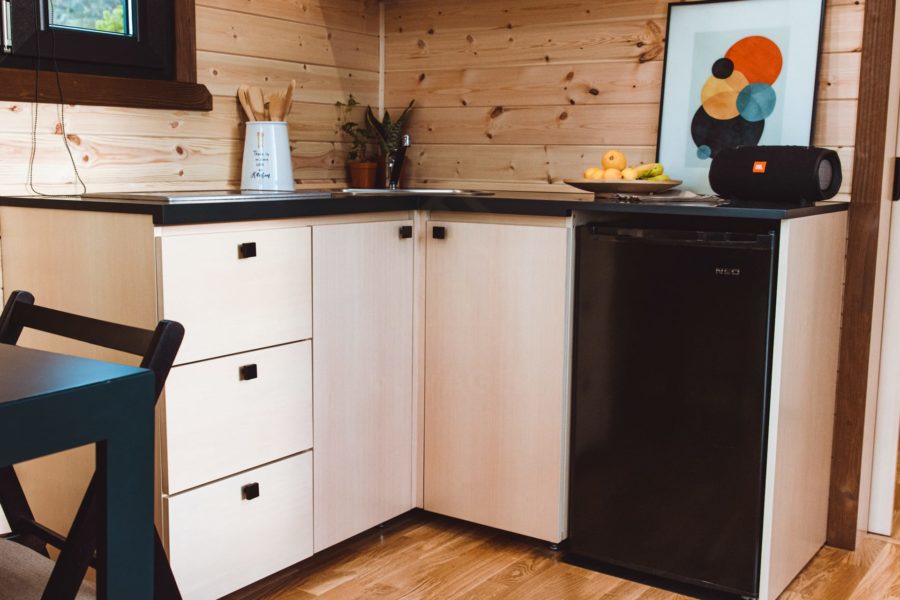
There are a couple upper cabinets.

And some beautiful display shelves.

Here’s that cozy bed we were talking about.

See the couch on the other side of the partition?

Wait until you watch it transform.

There’s also a skylight in the bedroom for stargazing.

Now you have a chaise! With storage underneath.

And now it’s a guest bed!

And now, it’s the bench for the table.

I like this long sink in the bathroom.
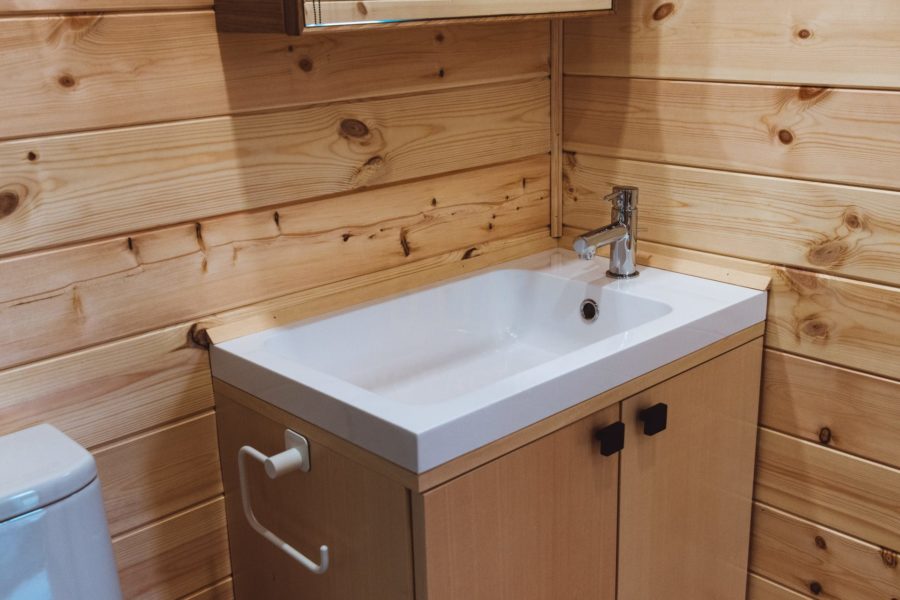
Modern flush toilet next to the shower stall.

The hot water heater is above the washer/dryer.

Easy to get those clothes clean.

Highlights:
Size (exterior) 6.60 X 2.52 X 3.95 meters (thanks to ingeniosity, this is now enough) Weight 3.5 Tones (can be towed with a B+E driving license) Wood NORDIC PINE Insulation ROCKWOOL / SHEEP WOOL (highly effective for temperature & sound isolation) Heating System ELECTRIC Water Heating ELECTRIC Trailer VLEMMIX / AL-KO (Top Rated in Europe – safe and reliable)
Learn more:
- Viking 1 Model
- Follow Voyager Houses on Instagram
Related stories:
- Hubble House Studio-Style Foundation Home
- Space-saving, hinged ladders to the lofts in this German tiny house
- Nordic Style Modular Tiny House in Germany
Our big thanks to Pavelina for sharing! 🙏
You can share this using the e-mail and social media re-share buttons below. Thanks!
If you enjoyed this you’ll LOVE our Free Daily Tiny House Newsletter with even more!
You can also join our Small House Newsletter !
Also, try our Tiny Houses For Sale Newsletter ! Thank you!
More Like This: Tiny Houses | THOWs | Tiny House Builders | Tiny Homes for Sale
See The Latest: Go Back Home to See Our Latest Tiny Houses
- Latest Posts
Natalie C. McKee
Latest posts by natalie c. mckee ( see all ).
- Serenity Now: Romantic Cabin in Vermont - May 1, 2024
- He Built a Spaceship Home Above a Two Car Garage - May 1, 2024
- 2022 VedaHawk Tiny Home in Alberta - April 30, 2024

Pretty good but no bedroom storage? Anything under the bed? How about above the washer unit and an upper corner cabinet in the kitchen would be more accessible – the couch/bed is good but where does the table go when not in use? No place for laundry/cleaning supplies unless bathroom vanity is used. This is ok for very short term use but can’t see living there.
The whole bed area is storage. The steps have storage, the area at the foot of the bed, behind the steps has an access panel you can lift… The trundle bed is split and both halves are pull out storage, and the table folds against the wall, it’s the “Get You There” wall art…
While you can’t really put anything over the water heater above the washer/dryer…
But people in Europe generally don’t need a lot and according to Eurostat, Romania, which is where this company is located, has the smallest average house size within the EU, only 44.3 square meters (~477 Sq Ft); even Latvia, the second to last in this category, has a significantly higher average, 70.9 square meters (~763 Sq Ft). This number in Bulgaria is 76.3 square meters (~821 Sq Ft), while the biggest homes can be found in Malta, where the average size is 160 square meters (~1722 Sq Ft).
Even in the UK house size is relatively small at 76 square meters (818 Sq Ft) and people living in apartments are used to even less space there…
It is cute, I think I would either, put bunk beds in, or a single, then there would be storage.
I do not get, why companies have to call things viking this or that. There is nothing which remotely resembles anything from the vikings about this house.
Though I do like this house. I would put in a frontloader washing machine instead, to be able to use the space above the machine. Craftsmanship is good.
Like many things, it’s not that simple. Names often have had different meanings over time. For instance, the word meat has not always been used to describe animal flesh, but it was once used to describe all solid food, including vegetables.
Viking is one of those terms who’s meaning has changed. Originally being a descriptive that in simplest terms meant explorer. Along with being linked to activities like being pirate, or freebooter, with related descriptive meanings like seafarer, etc. All of which essentially described what they did rather than what they called themselves.
So it’s only modern usage of the word viking(s) that has taken the word and applied it generically to just about everything related to the people, their culture, etc. from that time period but the original meaning is still understood and thus why it often gets used in that context, like the NASA Viking 1 and 2 Mars probes.
While this company has literally named itself Voyager, yet another name linked to exploration. So it actually makes perfect sense for them to call one of their models, made for going on trips, a name related to exploring and what their clients do from there is their business…
Do not try to come up with all sorts of made up explanations about the term viking. You are talking to a Dane, who actually knows about our history. It does not mean explorer – and never has meant explorer. Vík means a small, narrow bay – In Danish the word is still used and is called Vig. It originates from the word Víkin from the old nordic language, which is an actual area in Norway. It literrally means a person from Viken. And it has also been used as a maritime distance – a vika was a Nautic mile. The Anglo-Saxon word “wicing” was used for the first time, in the poem “Widsith”, and dates from the ninth century. It referred to Scandinavian pirates or robbers.
Sorry but I never make anything up and I already know all of that… People just tend to look at the past through the lens of their current cultural values, beliefs, and expectations, which is the mistake you’re making.
So it is essential to remember that in your ancestors’ times many of the ideals, concepts, and information we now take for granted had not developed yet. Early medieval Scandinavian peoples had no overarching name for themselves. They did not think that way. Instead, they identified themselves by family, clan, and tribal loyalties.
Vikings were also from Sweden, Denmark, and numerous other places. So there are many places in Scandinavia that has Vik in the name, it’s just more common in Norway. Besides, villages, regions, and municipalities with the name Vik, there are also rivers and inlets with the name. You just need to look at a map of Norway and you will see the name again and again. Towns and Villages with the name Vik can also be found on Iceland, which is an island in the North Atlantic ocean that was settled by the Vikings.
So the “Vík region” theory you’re referring is actually not something everyone agrees is accurate.
While you’re forgetting grammatical rules that words change meaning depending on how they’re used in a sentence, etc. and that’s basically the point your missing. Respected researchers like Dr. Jacqueline Simpson have gone in depth on the subject on all the lore, history, and culture of what details we know from the time period and is one of the reasons Vikings are associated with pirate, freebooter, etc. There’s a whole series of books on the subject…
You’re also forgetting how people viewed and romanticized that time period. Especially, during the 18th century when that era was first re-evaluated and appreciated. So there’s also what Vikings are most associated with doing, even if that didn’t include all of them…
Fact remains, there’s a long history of the name Viking used to name exploration vehicles, etc. Regardless of whether you want to believe the rest that much is indisputable!
There’s the NASA example I already gave, along with other examples like the Viking series of rockets. There’s companies like Viking Cruises and you can go to their website where they discuss the history of exploration and the many types of boats they manufacture. There’s military fully-amphibious vehicles named Viking. While, of course, there’s RV’s/Caravans that are also named Viking, and of course the fact Vikings did explore much of the world and that’s part of their legacy…
James, you are a classic example of the Dunning Kruger effect.
No, it’s never about ego with me and I’m well aware of my ability and limitations. I just don’t confuse opinions with facts. Nor do I assume I’m always right, my responses are just well researched and always based on the facts. While I don’t comment on things I haven’t researched and I recognize those who have a greater knowledge in any specific subject.
For example, the commentator that went by “Bigfoot” was much more knowledgeable than me about trucks and towing and there have been other commentators who have shown greater knowledge on agriculture, as another example.
My adherence to the facts just sometimes rubs people the wrong way but I always seek the truth, even if that ends up with me having to correct myself.
Respectfully, you have a good day…
The person who posts this article for US readers could’ve easily changed those meters to feet instead of making readers find an online converter to figure it out. Drives me crazy! I don’t bother to look it up anymore. I don’t know why the US doesn’t use the same metric system as the rest of the world, who started that, the Colonies? I’m way too old to learn it. — The metric system is the most used measurement system in the world. Only three countries in the world don’t use the metric system: the United States, Liberia, and Myanmar. Every other country around the world uses the metric system. Rant over. — The tiny house is nice but I don’t get why not save tons of money and just buy an RV. I’m a tiny house fan where tiny houses are built on the ground like other houses. Who can afford the gas now to haul those heavy tiny houses around anyway?
Nice clean design. Very livable. Love that guest bed is part of the versatility. I could happily live in this! Plenty of very accessible storage, if you ask me!
Leave a Comment
Notify me of follow-up comments by email.
Notify me of new posts by email.
This site uses Akismet to reduce spam. Learn how your comment data is processed .
Next post: Built his first Tiny House for $13k
Older post: Hubble House by Voyager Houses

Free Daily Tiny House Newsletter

Free Tiny House Plans
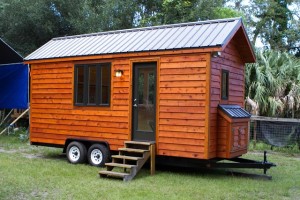
Tiny Houses For Sale

↑ Back to top ↑ 2010-2024 © Tiny House Media LLC. All Rights Reserved. Disclaimer, Usage Policy, Privacy Policy & DMCA Policy . Submit Content The content and information here is for entertainment and should not be taken as professional advice. While we strive to provide accurate and helpful information, we are not professionals. The owner of this website disclaims all warranties expressed or implied regarding the accuracy, timeliness, and completeness of the information provided. Tiny House Talk is the ultimate resource for tiny house enthusiasts. With an extensive library of articles, videos, and interviews featuring expert advice, stories from people who have made the switch to a smaller home, and more – it’s the perfect place to learn everything you need to know about going small! Get all your questions answered and start your tiny house journey today. Tiny House Talk lets you list tiny homes for sale or rent as a free service but Tiny House Media, LLC, TinyHouseTalk.com, and its contributors do not validate/verify the information we receive for these listings so it is your responsibility to verify the information we provide for you. Please do your due diligence and deal with people in person. Thank you. TinyHouseTalk.com participates in affiliate marketing programs. This means we may post customized links, provided by retailers, to track referrals to their websites, and we may earn an advertising fee from any purchases made through these links. This program uses cookies to track visits for the purposes of assigning commission on these sales. We are a participant in the Amazon Services LLC Associates Program, an affiliate advertising program designed to provide a means for us to earn fees by linking to Amazon.com and affiliated sites. Read our full disclaimer & policies here .
More From Forbes
Nasa celebrates as 1977’s voyager 1 phones home at last.
- Share to Facebook
- Share to Twitter
- Share to Linkedin
NASA’s Voyager 1 spacecraft is depicted in this artist’s concept traveling through interstellar ... [+] space, or the space between stars, which it entered in 2012.
Voyager 1 has finally returned usable data to NASA from outside the solar system after five months offline.
Launched in 1977 and now in its 46th year, the probe has been suffering from communication issues since November 14. The same thing also happened in 2022 . However, this week, NASA said that engineers were finally able to get usable data about the health and status of its onboard engineering systems.
Fixing Voyager 1 has been slow work. It’s currently over 15 billion miles (24 billion kilometers) from Earth, which means a radio message takes about 22.5 hours to reach it—and the same again to receive an answer.
The problem appears to have been its flight data subsystem, one of the spacecraft’s three onboard computers. Its job is to package the science and engineering data before it’s sent to Earth. Since the computer chip that stores its memory and some of its code is broken, engineers had to reinsert that code into a new location.
Next up for engineers at NASA’s Jet Propulsion Laboratory in California is to adjust other parts of the FDS software so Voyager 1 can resume sending science data.
Amazon Prime Video s Best New Show Arrives With A Perfect 100 Critic Score
Apple s iphone 16 pro design revealed in new leak, charlotte shooting 4 officers killed while serving warrant, beyond the ‘heliopause’.
The longest-running and most distant spacecraft in history, Voyager 1, was launched on September 5, 1977, while its twin spacecraft, Voyager 2, was launched a little earlier, on August 20, 1977. Voyager 2—now 12 billion miles away and traveling more slowly—continues to operate normally.
Both are now beyond what astronomers call the heliopause—a protective bubble of particles and magnetic fields created by the sun, which is thought to represent the sun’s farthest influence. Voyager 1 got to the heliopause in 2012 and Voyager 2 in 2018.
The Pale Blue Dot is a photograph of Earth taken Feb. 14, 1990, by NASA’s Voyager 1 at a distance of ... [+] 3.7 billion miles (6 billion kilometers) from the sun. The image inspired the title of scientist Carl Sagan's book, "Pale Blue Dot: A Vision of the Human Future in Space," in which he wrote: "Look again at that dot. That's here. That's home. That's us."
Pale Blue Dot
Since their launch from Cape Canaveral, Florida, aboard Titan-Centaur rockets, Voyager 1 and Voyager 2 have had glittering careers. Both photographed Jupiter and Saturn in 1979 and 1980 before going their separate ways. Voyager 1 could have visited Pluto, but that was sacrificed so scientists could get images of Saturn’s moon, Titan, a maneuver that made it impossible for it to reach any other body in the solar system. Meanwhile, Voyager 2 took slingshots around the planets to also image Uranus in 1986 and Neptune in 1989—the only spacecraft ever to image the two outer planets.
On February 14, 1990, when 3.7 billion miles from Earth, Voyager 1 turned its cameras back toward the sun and took an image that included our planet as “a mote of dust suspended in a sunbeam.” Known as the “Pale Blue Dot,” it’s one of the most famous photos ever taken. It was remastered in 2019 .
Wishing you clear skies and wide eyes.

- Editorial Standards
- Reprints & Permissions

Houses in Agreement With Your Own Terms & Conditions
Premium Materials & Architectural Design Houses that Empower Living More with Less
Retreat Houses
Houses with big windows, that bend with your environment.
Houses on Wheels
Houses Optimized for full-time Living, on a Detachable Trailer.
Custom Builds
Houses Imagined by You, Elevated and Built by us.
Craftmanship
Quality comes from creating with passion, care, and attention to detail. It is honed, refined, and practiced over the course of a career.
We recognize craftsmanship in the attention to the little details. We recognize craftsmanship in an object’s functionality. We recognize craftsmanship in an object’s durability.
Houses on Foundation
Off-grid energy systems, smart house solutions.

Hubble House
Years of Experience
Our specializations
Wood framed homes.
Our background and expertise come from building Wood Framed Houses, for a variety of clients from Europe. Therefore, with our knowledge and intuition, we feel confident that we are qualified for building high-quality tiny houses.
We already made the mistakes. We already learned. It just gets better.
Architectural Engineering
Architecture and its design and theory are as important to the construction process as virtually any other component.
We specialized to work on this side of the field and we are primarily involved with initial designs and brainstorming to get the most from any project.
High-End Finishes And Exquisite Decorations
Some may be surprised that matters of philosophy could work their way into something like construction. However, there is truly any number of ways philosophy can and does affect construction projects and even the practices and policies of many firms in the industry.
Eco-conscious design and materials vs. price, style and design appropriate for certain goals or environments, even the types of workers chosen for the jobs and how they are chosen.
Just a few details for you to make an idea.
Crossing the Frontier of Low Quality
Free consultation.
We will help you with the knowledge needed to build a tiny house that fits your needs and wishes.
High quality
Reputation is key for us, so we treat each order responsibly and try to achieve the highest possible results.
Reasonable prices
We don’t aim to build cheap houses, we aim to build houses that have the best quality/price ratio.

Guarantees are provided for all types of work because we are confident in their quality.
Individual approach
We successfully select solutions for our clients that best suit their budget and listen to their wishes.
Healthy & Eco-Friendly
Picking materials that are Safe and Healthy for you or the environment is one of the highest priorities for us.
What people who rented Hubble House feel about it.

Home About Us Services Contact Voyager 1 Hubble House Viking 1
+40 734 459 078 (RO)
Romania, Neamț, Săvinești, Str. Gheorghe Caranfil, Nr. 2, 617410
© 2021 All rights reserved.
Inside NASA's 5-month fight to save the Voyager 1 mission in interstellar space

After working for five months to re-establish communication with the farthest-flung human-made object in existence, NASA announced this week that the Voyager 1 probe had finally phoned home.
For the engineers and scientists who work on NASA’s longest-operating mission in space, it was a moment of joy and intense relief.
“That Saturday morning, we all came in, we’re sitting around boxes of doughnuts and waiting for the data to come back from Voyager,” said Linda Spilker, the project scientist for the Voyager 1 mission at NASA’s Jet Propulsion Laboratory in Pasadena, California. “We knew exactly what time it was going to happen, and it got really quiet and everybody just sat there and they’re looking at the screen.”
When at long last the spacecraft returned the agency’s call, Spilker said the room erupted in celebration.
“There were cheers, people raising their hands,” she said. “And a sense of relief, too — that OK, after all this hard work and going from barely being able to have a signal coming from Voyager to being in communication again, that was a tremendous relief and a great feeling.”

The problem with Voyager 1 was first detected in November . At the time, NASA said it was still in contact with the spacecraft and could see that it was receiving signals from Earth. But what was being relayed back to mission controllers — including science data and information about the health of the probe and its various systems — was garbled and unreadable.
That kicked off a monthslong push to identify what had gone wrong and try to save the Voyager 1 mission.
Spilker said she and her colleagues stayed hopeful and optimistic, but the team faced enormous challenges. For one, engineers were trying to troubleshoot a spacecraft traveling in interstellar space , more than 15 billion miles away — the ultimate long-distance call.
“With Voyager 1, it takes 22 1/2 hours to get the signal up and 22 1/2 hours to get the signal back, so we’d get the commands ready, send them up, and then like two days later, you’d get the answer if it had worked or not,” Spilker said.

The team eventually determined that the issue stemmed from one of the spacecraft’s three onboard computers. Spilker said a hardware failure, perhaps as a result of age or because it was hit by radiation, likely messed up a small section of code in the memory of the computer. The glitch meant Voyager 1 was unable to send coherent updates about its health and science observations.
NASA engineers determined that they would not be able to repair the chip where the mangled software is stored. And the bad code was also too large for Voyager 1's computer to store both it and any newly uploaded instructions. Because the technology aboard Voyager 1 dates back to the 1960s and 1970s, the computer’s memory pales in comparison to any modern smartphone. Spilker said it’s roughly equivalent to the amount of memory in an electronic car key.
The team found a workaround, however: They could divide up the code into smaller parts and store them in different areas of the computer’s memory. Then, they could reprogram the section that needed fixing while ensuring that the entire system still worked cohesively.
That was a feat, because the longevity of the Voyager mission means there are no working test beds or simulators here on Earth to test the new bits of code before they are sent to the spacecraft.
“There were three different people looking through line by line of the patch of the code we were going to send up, looking for anything that they had missed,” Spilker said. “And so it was sort of an eyes-only check of the software that we sent up.”
The hard work paid off.
NASA reported the happy development Monday, writing in a post on X : “Sounding a little more like yourself, #Voyager1.” The spacecraft’s own social media account responded , saying, “Hi, it’s me.”
So far, the team has determined that Voyager 1 is healthy and operating normally. Spilker said the probe’s scientific instruments are on and appear to be working, but it will take some time for Voyager 1 to resume sending back science data.
Voyager 1 and its twin, the Voyager 2 probe, each launched in 1977 on missions to study the outer solar system. As it sped through the cosmos, Voyager 1 flew by Jupiter and Saturn, studying the planets’ moons up close and snapping images along the way.
Voyager 2, which is 12.6 billion miles away, had close encounters with Jupiter, Saturn, Uranus and Neptune and continues to operate as normal.
In 2012, Voyager 1 ventured beyond the solar system , becoming the first human-made object to enter interstellar space, or the space between stars. Voyager 2 followed suit in 2018.
Spilker, who first began working on the Voyager missions when she graduated college in 1977, said the missions could last into the 2030s. Eventually, though, the probes will run out of power or their components will simply be too old to continue operating.
Spilker said it will be tough to finally close out the missions someday, but Voyager 1 and 2 will live on as “our silent ambassadors.”
Both probes carry time capsules with them — messages on gold-plated copper disks that are collectively known as The Golden Record . The disks contain images and sounds that represent life on Earth and humanity’s culture, including snippets of music, animal sounds, laughter and recorded greetings in different languages. The idea is for the probes to carry the messages until they are possibly found by spacefarers in the distant future.
“Maybe in 40,000 years or so, they will be getting relatively close to another star,” Spilker said, “and they could be found at that point.”
Denise Chow is a reporter for NBC News Science focused on general science and climate change.

07470004191 | [email protected] | 106a High Street, Barnstaple, EX31 1HP
Redefine Living with Wood-Framed Houses from Voyager Houses UK
Proudly Serving Clients throughout the UK
Our Services
As well as producing high-quality tiny houses, we provide smart house solutions, off-grid energy systems, and expert architectural consultancy services.
Quality Craftsmanship
With extensive experience of building wood-framed houses in Europe, we have the knowledge and intuition to deliver high-quality tiny houses. We’ve made the mistakes and we’ve already learned from them, so our products just keep getting better.
What We Offer
Houses on Wheels
Static Houses
Custom Builds
Smart House Solutions
Off-Grid Energy Systems
Consulting
Our Products
At Voyager Houses, we design and create an array of wood-framed houses for clients throughout the UK. The company we work with who build the tiny houses has more than 10 years experience and our construction company offers solutions that are optimised for your needs. Providing consummate craftsmanship on every job, we take pride in our attention to the little details while also delivering on functionality and durability. Whether you’re looking for a static structure or a house on wheels, we build the home you imagine for yourself. Get in touch today to discover more.
Architectural Engineering
The theory and design of architecture are as important to the construction process as any other part of it. Specialising in this field, we get involved from the very first ideas and designs to ensure you get the most from any project. We also carefully choose the best eco-friendly materials for your needs and budget.
Why Choose Us?
Free Consultation
Backed by knowledge and experience, we will help you build a tiny house that suits your needs and wishes.
High Quality
We treat every order with equal importance, which is how we have developed our reputation for great results.
Reasonable Prices
Offering an unbeatable quality/price ratio, we don’t build cheap houses, we build cost-effective ones
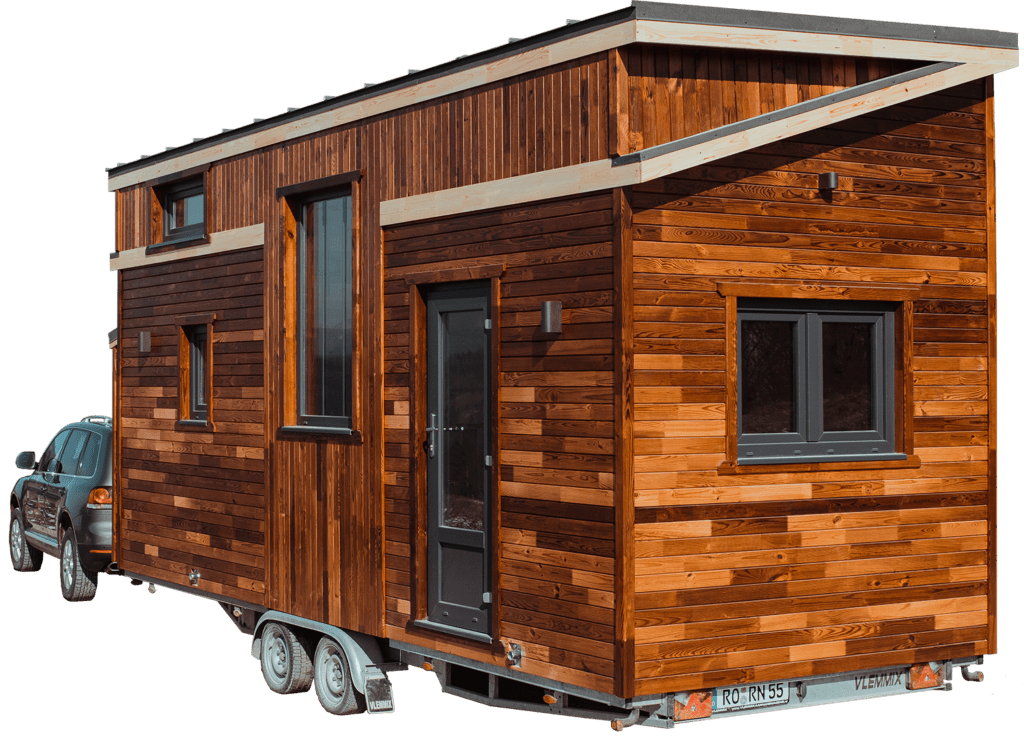
Confident of our quality workmanship, we guarantee all types of work..
Individual Approach
Paying close attention to clients’ wishes, we carefully tailor solutions to your needs and budget.
Healthy and Eco-Friendly
We always select safe, healthy, and environmentally friendly materials to suit your requirements.
Premium Materials and Designs
Our construction company specialises in creating mobile and static wood-framed houses.
Testimonials
The tiny house under the cherry tree – Booking.com
Exceptional
The location is wonderful. :) Everything is new and chosen with great taste, and the landscape exceeded our expectations. From the terrace of the house I had a view of the pine forest and the lake. The hosts, although we did not meet them physically, were very nice to us and suggested routes to visit, gave us some directions to feel as comfortable as possible in the location and suggested a place where we could order food. We will definitely be back.
Oana - Romania
The whole experience was superlative. The dream location, exactly what I've been looking for a long time. We were lucky to catch the cherry blossoms, all green and wonderful. The host, extraordinary. Too bad the pictures can't show exactly what the eyes see, because that's the only way to do justice to reality. We can't wait to come back! PS. Thank you for the perfect opportunity to make the perfect gift for your loved one!
Renata - Romania
A different Experience
We really liked the accommodation, the location is absolutely beautiful, from the comfort of the bed we felt like we were outside. Inevitably you look around all the time, attracted by the view. We also made routes nearby, at the directions received from the host. It was clean, warm, everything needed. I would return here, it is among the most unique accommodations in Romania where we stayed. The host was nice, she contacted us on the day of the check-in with all the necessary information.
Diana - Romania
Voyager: 15 incredible images of our solar system captured by the twin probes (gallery)
The twin probes have captured some remarkable images of our cosmic neighborhood.

NASA's twin probes Voyager 1 and Voyager 2 have captured some truly remarkable images of our solar system and are currently roaming through interstellar space.
Despite its name Voyager 2 launched before Voyager 1 , when it lifted off from Cape Canaveral Space Launch Complex 41 aboard a Titan IIIE-Centaur on Aug. 20, 1977. Voyager 1 followed suit about two weeks later on Sept. 5.
While Voyager 1 primarily focused on Jupiter and Saturn , Voyager 2 visited both gas giants and then ventured on to Uranus and Neptune . But the duo didn't stop there. Voyager 1 officially entered interstellar space on Aug. 25, 2012, while Voyager 2 entered on Nov. 5, 2018. The pair continue to journey through the cosmos and have enough power and fuel to keep scientific instruments running until at least 2025, according to NASA .
Here we celebrate the achievements of both Voyager 1 and Voyager 2 with some incredible images captured by the pair.
This image was taken when NASA's Voyager 1 spacecraft zoomed toward Jupiter in January and February 1979, capturing hundreds of images during its approach, including this close-up of swirling clouds around Jupiter's Great Red Spot .
This image of the Earth and moon are in a single frame. Voyager was the first spacecraft to achieve this and captured the iconic image on Sept. 18, 1977, by Voyager 1 when it was 7.25 million miles from Earth. The moon is at the top of the picture and beyond the Earth as viewed by Voyager.
Color composite by Voyager 2 showing Jupiter's faint ring system. Images captured in July 1979.
A Voyager 1 image of Jupiter's moon Io showing the active plume of the volcano Loki. The heart-shaped feature southeast of Loki consists of fallout deposits from the active plume Pele. The images that make up this mosaic were taken from an average distance of approximately 340,000 miles (490,000 kilometers) from the moon.
Layers of haze covering Saturn's moon Titan are seen in this image taken by Voyager 1 on Nov. 12, 1980, at a range of 13,700 miles (22,000 km). This false-color image shows the details of the haze that covers Titan. The upper level of the thick aerosol above the moon's limb appears orange.
This view of Uranus was recorded by Voyager 2 on Jan. 25, 1986, as the spacecraft left the planet behind and set forth on the cruise to Neptune. Even at this extreme angle, Uranus retains the pale blue-green color seen by ground-based astronomers and recorded by Voyager during the historic encounter.
This Voyager 2 high-resolution color image provides obvious evidence of vertical relief in Neptune's bright cloud streaks. These clouds were observed at a latitude of 29 degrees north near Neptune's east terminator, the "line" on a planet where daylight meets darkness.
Global color mosaic of Triton , taken in 1989 by Voyager 2 during its flyby of the Neptune system. The color was synthesized by combining high-resolution images taken through orange, violet and ultraviolet filters; these images were displayed as red, green and blue images and combined to create this color version.
Saturn and three of its moons, Tethys, Dione and Rhea, seen by a Voyager spacecraft on Aug. 4, 1982, from a distance of 13 million miles (21 million km).
This narrow-angle color image of the Earth, dubbed the "Pale Blue Dot," is a part of the first ever 'portrait' of the solar system taken by Voyager 1. The spacecraft acquired a total of 60 frames for a mosaic of the solar system from a distance of more than 4 billion miles (6 billion km) from Earth and about 32 degrees above the ecliptic, which is the plane that contains most of the planets of the solar system.
Voyager 1 took photos of Jupiter and two of its satellites (Io, left, and Europa ).
Enhanced color view of Saturn's ring system captured by Voyager 2 on Aug. 17, 1981, at a distance of 5.5 million miles (8.9 million km). The color variations between the rings possibly indicate variations in chemical composition from one part of Saturn's ring system to another.
Close-up of the surface of Jupiter's moon Europa captured by Voyager 2 at a distance of 152,000 miles (246,000 km).
Voyager 2 captured this image of Neptune's rings on Aug. 26, 1989, from a distance of 175,000 miles (280,000 km).
A false-color image of Callisto captured on July 7, 1979, by Voyager 2 at a distance of about 677,000 miles (1.09 million km). Callisto is the second largest moon of Jupiter and is the most heavily cratered of the Galilean satellites.

Daisy Dobrijevic joined Space.com in February 2022 having previously worked for our sister publication All About Space magazine as a staff writer. Before joining us, Daisy completed an editorial internship with the BBC Sky at Night Magazine and worked at the National Space Centre in Leicester, U.K., where she enjoyed communicating space science to the public. In 2021, Daisy completed a PhD in plant physiology and also holds a Master's in Environmental Science, she is currently based in Nottingham, U.K. Daisy is passionate about all things space, with a penchant for solar activity and space weather. She has a strong interest in astrotourism and loves nothing more than a good northern lights chase!
- Mike Wall Senior Space Writer
China to launch sample-return mission to the moon's far side on May 3
Mars exploration, new rockets and more: Interview with ESA chief Josef Aschbacher
What would happen if the moon disappeared?
Most Popular
- 2 Boeing Starliner 1st astronaut flight: Live updates
- 3 Horsehead Nebula rears its head in gorgeous new James Webb Space Telescope images (video)
- 4 China to launch sample-return mission to the moon's far side on May 3
- 5 Boeing Starliner astronauts conduct dress rehearsal ahead of May 6 launch (photos, video)
Voyager Image Gallery
45 years of voyager i and ii.
Launched in 1977, NASA’s twin Voyager spacecraft inspired the world with pioneering visits to Jupiter, Saturn, Uranus, and Neptune. Their journey continues 45 years later as both probes explore interstellar space, the region outside the protective heliosphere created by our Sun. Researchers – some younger than the spacecraft – are now using Voyager data to solve mysteries of our solar system and beyond.

This archival photo shows engineers working on vibration acoustics and pyro shock testing of NASA’s Voyager on Nov. 18, 1976.

NASA’s Voyager 1 acquired this image of a volcanic explosion on Io on March 4, 1979, about 11 hours before the spacecraft’s closest approach to the moon of Jupiter.

This updated version of the iconic "Pale Blue Dot" image taken by the Voyager 1 spacecraft uses modern image-processing software and techniques to revisit the well-known Voyager view while attempting to respect the original data and intent of those who planned the images.

This illustrated graphic was made to mark Voyager 1’s entry into interstellar space in 2012. It puts solar system distances in perspective, with the scale bar in astronomical units and each set distance beyond 1 AU (the average distance between the Sun and Earth) representing 10 times the previous distance.

This graphic highlights some of the Voyager mission’s key accomplishments. Credit: NASA/JPL-Caltech Full image details

This graphic provides some of the mission’s key statistics from 2018, when NASA’s Voyager 2 probe exited the heliosphere. Credit: NASA/JPL-Caltech Full image details
NASA Hears From Voyager 1, the Most Distant Spacecraft From Earth, After Months of Quiet
NASA has finally heard back from Voyager 1 in a way that makes sense

This illustration provided by NASA depicts Voyager 1. The most distant spacecraft from Earth stopped sending back understandable data in November 2023. Flight controllers traced the blank communication to a bad computer chip and rearranged the spacecraft’s coding to work around the trouble. In mid-April 2024, NASA’s Jet Propulsion Laboratory declared success after receiving good engineering updates. The team is still working to restore transmission of the science data. (NASA via AP)
CAPE CANAVERAL, Fla. (AP) — NASA has finally heard back from Voyager 1 again in a way that makes sense.
The most distant spacecraft from Earth stopped sending back understandable data last November. Flight controllers traced the blank communication to a bad computer chip and rearranged the spacecraft’s coding to work around the trouble.
NASA’s Jet Propulsion Laboratory in Southern California declared success after receiving good engineering updates late last week. The team is still working to restore transmission of the science data.
It takes 22 1/2 hours to send a signal to Voyager 1, more than 15 billion miles (24 billion kilometers) away in interstellar space. The signal travel time is double that for a round trip.
Contact was never lost, rather it was like making a phone call where you can’t hear the person on the other end, a JPL spokeswoman said Tuesday.
Launched in 1977 to study Jupiter and Saturn, Voyager 1 has been exploring interstellar space — the space between star systems — since 2012. Its twin, Voyager 2, is 12.6 billion miles (20 billion kilometers) away and still working fine.
Photos You Should See - April 2024

The Associated Press Health and Science Department receives support from the Howard Hughes Medical Institute’s Science and Educational Media Group. The AP is solely responsible for all content.
Copyright 2024 The Associated Press . All rights reserved. This material may not be published, broadcast, rewritten or redistributed.
Join the Conversation
Tags: Associated Press , science
America 2024

Health News Bulletin
Stay informed on the latest news on health and COVID-19 from the editors at U.S. News & World Report.
Sign in to manage your newsletters »
Sign up to receive the latest updates from U.S News & World Report and our trusted partners and sponsors. By clicking submit, you are agreeing to our Terms and Conditions & Privacy Policy .
You May Also Like
The 10 worst presidents.
U.S. News Staff Feb. 23, 2024

Cartoons on President Donald Trump
Feb. 1, 2017, at 1:24 p.m.

Photos: Obama Behind the Scenes
April 8, 2022

Photos: Who Supports Joe Biden?
March 11, 2020

Nationwide Campus Protests Escalate
Laura Mannweiler April 30, 2024


What to Know: Trump Gag Order Violations
Lauren Camera April 30, 2024

Different jobs with med degree
Jarek Rutz April 30, 2024

Motion To Oust Johnson Dead On Arrival
Aneeta Mathur-Ashton April 30, 2024

Consumers Losing Confidence in Economy
Tim Smart April 30, 2024

Home Prices Rise, Defying Mortgage Rates

NASA's Voyager probes have been traveling through space for nearly 46 years. Here are 18 groundbreaking photos from their incredible mission.
- Nearly 46 years after their launch, Voyager 1 and 2 will likely soon reach the end of their scientific mission .
- NASA recently lost contact with Voyager 2 after sending it a bad command by mistake.
- Here are 18 pictures the probes took over the course of their forty-plus-year journey.

The Voyager probes are pioneers of science, making it farther into space than any other manufactured object. But now, they face a terminal problem: their power is running out.
The twin probes were originally sent on a four-year mission to tour the solar system, but they exceeded all expectations and are still going nearly 46 years later. That makes them NASA's longest-lived mission.
Scientists are now doing their best to keep the probes going for as long as possible. They recently found a clever hack to extend Voyager 2's life for another three years and plan to do the same with Voyager 1.
But these are old machines and NASA is constantly scrambling to fix mistakes. Last year, Voyager 1 started sending garbled data from the outside of the solar system. NASA ultimately figured out one of its computers had gone dead.
Voyager 2 is now in limbo , as the agency revealed Friday it had lost contact with the probe when someone sent a wrong command. It could be the end of Voyager 2's mission if NASA can't fix the mistake, which the agency probably won't be able to do before October.
As the probes are nearing the end of their scientific mission, here are 18 images from Voyager that changed science.
The Voyager probes were designed to visit Jupiter and Saturn.
The Voyager mission included two probes — Voyager 1 and Voyager 2 — which NASA launched in 1977 within a few months of each other.
NASA took advantage of a rare planet alignment to turbocharge their journeys into space.
NASA originally built the probes to last five years, but they have exceeded that lifespan many times .
As of August 20 and September 5, 2023, Voyager 2 and Voyager 1 will have been traveling for 46 years, respectively.
This is what Voyager 1 saw on its approach to Jupiter.
Voyager 1 and Voyager 2 reached Jupiter in 1979.
As they flew by the planet, they took about 50,000 pictures of Jupiter. These blew away scientists, as the quality of the pictures was much better than those taken from Earth, according to NASA.
These snaps taught scientists important facts about the planet's atmosphere, magnetic forces, and geology that would have been difficult to decipher otherwise.
The probes discovered two new moons orbiting Jupiter: Thebe and Metis.
They also spotted a thin ring around Jupiter.
The probe captured this picture as it was looking back at the planet backlit by the Sun.
Voyager 1 discovered volcanoes at the surface of Io, one of Jupiter's moons.
Next stop: Saturn.
In 1980 and 1981, the probes reached Saturn . The flyby gave scientists unprecedented insight into the planet's ring structure, atmosphere, and moons.
Voyager snapped Saturn's rings in more detail than ever before.
And showed every secret that Enceladus, Saturn's moon, had to offer.
Saturn, snapped as the probe flew away, was shown in a new light.
By 1986, Voyager 2 had made it to Uranus.
By 1986, Voyager 1 has finished its grand tour of the solar system, and few out towards space. But Voyager 2 kept on its exploring our nearest planets, passing 50,600 miles away from Uranus in January 1986.
Voyager 2 discovered two extra rings around Uranus , revealing the planet had at least 11, not 9.
Voyager 2 also spotted 11 previously unseen moons around Uranus.
Here is a picture of Miranda, Uranus's sixth-biggest moon.
Voyager 2 was the first spacecraft to observe Neptune from a close distance.
In 1989, 12 years after its launch, Voyager 2 passed within 3,000 miles of Neptune.
Here's Nepture taken by Voyager 2, in all its blue glory.
Voyager 2 took this unflattering pic of Triton's rough face.
It captured Triton, Neptune's moon in unprecedented detail.
And snapped Triton's southern hemisphere.
As it flew by, Voyager 2 uncovered Neptune's rings.
As its parting gift, Voyager 2 took this beautiful picture of light grazing Neptune's south pole.
This is Voyager 2's last picture. Since it wouldn't come across another planet on its ongoing journey, NASA switched off its cameras after its flyby of Neptune to conserve energy for other instruments.
Voyager 1 had one last trick up its sleeve.
As its last photographic hurrah in 1990, Voyager 1 took 60 images of the solar system from 4 billion miles away.
It gave us the Earth's longest selfie, dubbed the "pale blue dot."
This remains the longest-range selfie: a portrait of the Earth taken by a human-made probe from 4 billion miles away.
After this picture, NASA switched off Voyager 1's cameras to save energy. NASA could switch the probes' cameras back on , but it is not a priority for the mission.
Beyond the solar system
Though the probes are no longer sending pictures, they haven't stopped sending crucial information about space.
In 2012, Voyager 1 became the first human-made instrument to cross into interstellar space by crossing the boundary between our solar system and the rest of the universe, called the heliopause.
Voyager 2 was second, crossing that threshold in 2018 . The probe revealed that there was yet another layer outside of our heliosphere.
The probes keep sending back measurements from interstellar space, like weird hums likely coming from vibrations made by neighboring stars.
Even after their instruments are switched off, the probes' mission continues.
NASA is planning to switch more of the probes' instruments in the hope of extending their life to the 2030s.
But even after all their instruments become quiet, their mission will carry on. As they drift off, they will still be carrying a golden record that carries crucial information about humanity. If intelligent extraterrestrial life exists, they could use that information to reach out to us.
This article was originally published on June 6, 2022, and is being updated with the latest developments about Voyager 1 and 2.
- Main content

- The Contents
- The Making of
- Where Are They Now
- Frequently Asked Questions
- Q & A with Ed Stone
golden record
Where are they now.
- frequently asked questions
- Q&A with Ed Stone
galleries / images voyager took
Solar system portrait.
This narrow-angle color image of the Earth, dubbed 'Pale Blue Dot', is a part of the first ever 'portrait' of the solar system taken by Voyager 1. The spacecraft acquired a total of 60 frames for a mosaic of the solar system from a distance of more than 4 billion miles from Earth and about 32 degrees above the ecliptic. From Voyager's great distance Earth is a mere point of light, less than the size of a picture element even in the narrow-angle camera. Earth was a crescent only 0.12 pixel in size. Coincidentally, Earth lies right in the center of one of the scattered light rays resulting from taking the image so close to the sun. This blown-up image of the Earth was taken through three color filters — violet, blue and green — and recombined to produce the color image. The background features in the image are artifacts resulting from the magnification.
Solar System Portrait - 60 Frame Mosaic.

Solar System Portrait - Earth as 'Pale Blue Dot'.
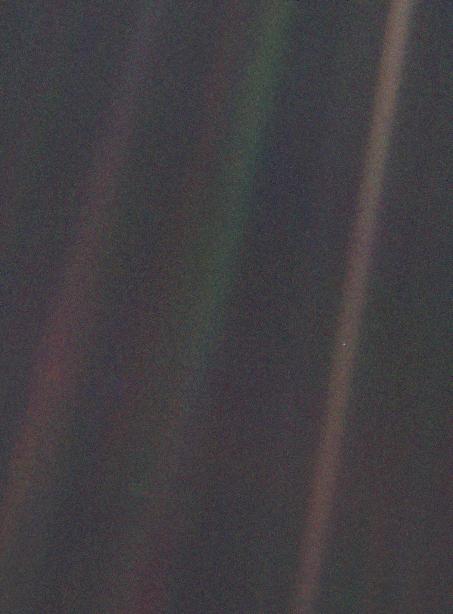
share this!
April 27, 2024
This article has been reviewed according to Science X's editorial process and policies . Editors have highlighted the following attributes while ensuring the content's credibility:
fact-checked
reputable news agency
NASA hears from Voyager 1, the most distant spacecraft from Earth, after months of quiet
by Marcia Dunn
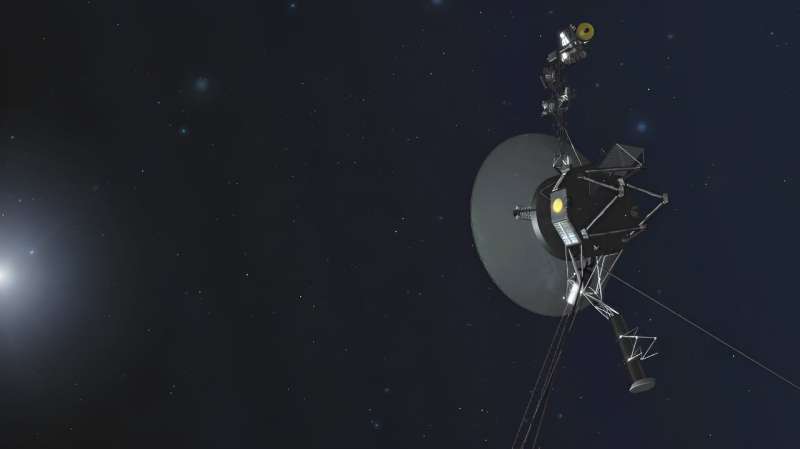
NASA has finally heard back from Voyager 1 again in a way that makes sense.
The most distant spacecraft from Earth stopped sending back understandable data last November. Flight controllers traced the blank communication to a bad computer chip and rearranged the spacecraft's coding to work around the trouble.
NASA's Jet Propulsion Laboratory in Southern California declared success after receiving good engineering updates late last week. The team is still working to restore transmission of the science data.
It takes 22 1/2 hours to send a signal to Voyager 1, more than 15 billion miles (24 billion kilometers) away in interstellar space . The signal travel time is double that for a round trip.
Contact was never lost, rather it was like making a phone call where you can't hear the person on the other end, a JPL spokeswoman said Tuesday.
Launched in 1977 to study Jupiter and Saturn, Voyager 1 has been exploring interstellar space — the space between star systems — since 2012. Its twin, Voyager 2, is 12.6 billion miles (20 billion kilometers) away and still working fine.
© 2024 The Associated Press. All rights reserved. This material may not be published, broadcast, rewritten or redistributed without permission.
Explore further
Feedback to editors

New observatory in Chile—the highest in the world—aims to reveal origins of planets, galaxies and more
9 hours ago

Study uncovers the secret of long-lived stem cells
13 hours ago

Scientists show that ancient village adapted to drought, rising seas
14 hours ago

How polyps of the moon jellyfish repel viral attacks on their microbiome

Organic electrochemical transistors: Scientists solve chemical mystery at the interface of biology and technology
15 hours ago

Activity in a room stirs up nanoparticles left over from consumer sprays, study shows

Study dispels myth that purebred dogs are more prone to health problems
16 hours ago

Study shows climate change and mercury pollution stressed plants for millions of years
17 hours ago

Exploiting disorder to harvest heat energy: The potentialities of 2D magnets for thermoelectric applications

Citizen scientists help discover record-breaking exoplanet in binary star system
Relevant physicsforums posts, the james webb space telescope, documenting the setup of my new telescope.
Apr 28, 2024
Quasi-Moons
Need help simplifying standard error formula for redshift.
Apr 27, 2024
Our Beautiful Universe - Photos and Videos
Apr 25, 2024
Solar Activity and Space Weather Update thread
More from Astronomy and Astrophysics
Related Stories

NASA's Voyager 1 resumes sending engineering updates to Earth
Apr 22, 2024

NASA hears signal from Voyager 2 spacecraft after mistakenly cutting contact
Aug 1, 2023

NASA listens for Voyager 2 spacecraft after wrong command cuts contact
Jul 31, 2023

Engineers working to resolve issue with Voyager 1 computer
Dec 13, 2023
As Voyager 1's mission draws to a close, one planetary scientist reflects on its legacy
Mar 18, 2024

NASA back in touch with Voyager 2 after 'interstellar shout'
Aug 4, 2023
Recommended for you

Novel calculations peg age of 'baby' asteroid

Clouds blanket the night side of the hot exoplanet WASP-43b
18 hours ago

Enceladus spills its guts through strike–slip motion

New study reveals mystery of decaying exoplanet orbits
Apr 29, 2024

Probing the effects of interplanetary space on asteroid Ryugu
Let us know if there is a problem with our content.
Use this form if you have come across a typo, inaccuracy or would like to send an edit request for the content on this page. For general inquiries, please use our contact form . For general feedback, use the public comments section below (please adhere to guidelines ).
Please select the most appropriate category to facilitate processing of your request
Thank you for taking time to provide your feedback to the editors.
Your feedback is important to us. However, we do not guarantee individual replies due to the high volume of messages.
E-mail the story
Your email address is used only to let the recipient know who sent the email. Neither your address nor the recipient's address will be used for any other purpose. The information you enter will appear in your e-mail message and is not retained by Phys.org in any form.
Newsletter sign up
Get weekly and/or daily updates delivered to your inbox. You can unsubscribe at any time and we'll never share your details to third parties.
More information Privacy policy
Donate and enjoy an ad-free experience
We keep our content available to everyone. Consider supporting Science X's mission by getting a premium account.
E-mail newsletter
NASA hears from Voyager 1, the most distant spacecraft from Earth, after months of quiet
NASA has finally heard back from Voyager 1 in a way that makes sense
CAPE CANAVERAL, Fla. -- NASA has finally heard back from Voyager 1 again in a way that makes sense.
The most distant spacecraft from Earth stopped sending back understandable data last November. Flight controllers traced the blank communication to a bad computer chip and rearranged the spacecraft’s coding to work around the trouble.
NASA’s Jet Propulsion Laboratory in Southern California declared success after receiving good engineering updates late last week. The team is still working to restore transmission of the science data.
It takes 22 1/2 hours to send a signal to Voyager 1, more than 15 billion miles (24 billion kilometers) away in interstellar space. The signal travel time is double that for a round trip.
Contact was never lost, rather it was like making a phone call where you can’t hear the person on the other end, a JPL spokeswoman said Tuesday.
Launched in 1977 to study Jupiter and Saturn, Voyager 1 has been exploring interstellar space — the space between star systems — since 2012. Its twin, Voyager 2, is 12.6 billion miles (20 billion kilometers) away and still working fine.
The Associated Press Health and Science Department receives support from the Howard Hughes Medical Institute’s Science and Educational Media Group. The AP is solely responsible for all content.
Top Stories

'Surprising' and 'disturbing': Legal experts react to SCOTUS on Trump immunity case
- Apr 30, 6:52 AM

College protests updates: Protesters clash on UCLA campus, LAPD responds
- 3 hours ago

Trump says 'it depends' if there will be violence if he loses 2024 election to Biden
- Apr 30, 1:24 PM

2 men are charged with cutting down famous 150-year-old tree near Hadrian's Wall in England
- Apr 30, 12:13 PM

Justice Stephen Breyer's blunt message to Supreme Court conservatives: 'Slow down'
Abc news live.
24/7 coverage of breaking news and live events

IMAGES
VIDEO
COMMENTS
Images via Voyager Houses. Treated wood exterior and metal roofing. Images via Voyager Houses. Highlights: Size (exterior) 8.0 X 3.2 X 3.4 meters (thanks to ingeniosity, this is now enough) Structure Treated Solid Wood and Lamellar Glass Reflective, Secured, and Laminated Heating System ELECTRIC & WOOD (stay warm and comfy) Water Heating GAS ...
When Voyager 1 and Voyager 2 launched into space in 1977, their mission was to explore the outer solar system, and over the following decade, they did so admirably.. With an 8-track tape memory ...
On Feb. 14, 1990, NASA's Voyager 1 probe snapped a photo of Earth from 3.7 billion miles (6 billion kilometers) away. ... (Random House, 1994). Earth was one of the last things Voyager 1 saw. The ...
Images via Voyager Houses. You can see the "big house" off in the distance. Images via Voyager Houses. Highlights: Size (exterior) 7.20 X 2.52 X 3.95 meters (thanks to ingeniosity, this is now enough) Weight 3.5 Tones (can be towed with a B+E driving license) Wood NORDIC PINE Insulation ROCKWOOL / SHEEP WOOL (highly effective for ...
Built his first Tiny House for $13k. Hubble House by Voyager Houses. 5x8 Tiny House. 8x8 Tiny House. 8x12 Tiny House. 8x16 Solar Tiny House. 8x20 Solar Tiny House. 12x24 Cabin Plans. We showed off the "Hubble House" from Voyager Houses yesterday, and today we want to show you one of their THOWs.
Voyager 2 radioed thousands of images and voluminous amounts of other scientific data on the planet, its moons, rings, atmosphere, interior and the magnetic environment surrounding Uranus. Neptune In the summer of 1989, NASA's Voyager 2 became the first spacecraft to observe the planet Neptune, its final planetary target. Passing about 4,950 ...
Voyager 1 got to the heliopause in 2012 and Voyager 2 in 2018. The Pale Blue Dot is a photograph of Earth taken Feb. 14, 1990, by NASA's Voyager 1 at a distance of ... [+] 3.7 billion miles (6 ...
The probe and its twin, Voyager 2, are the only spacecraft to ever fly in interstellar space (the space between stars). Voyager 1 stopped sending readable science and engineering data back to Earth on Nov. 14, 2023, even though mission controllers could tell the spacecraft was still receiving their commands and otherwise operating normally.
1720x1720x3. PIA18182: Uranus as seen by NASA's Voyager 2. Full Resolution: TIFF (8.879 MB) JPEG (78.82 kB) 1989-10-02. Triton. Voyager. 932x1884x1. PIA14448:
Voyager 1. Just a few details for you to make an idea. Size (exterior) 7.05 X 2.52 X 3.95 meters (thanks to ingeniosity, this is now enough) Weight. 3.5 Tones (can be towed with a B+E driving license) Wood. CEMBRA PINE (healthy for your lungs and well-being) Insulation.
Images. A House That Redefines Living. There's never been a better time to discover our Voyager 1 wood-framed houses. Find out More. Get in touch. 07470 004191. Service Area. Proudly Serving Clients throughout the UK. Business Hours. Tuesday - Saturday 08:00 - 16:30
The Voyager 1 and 2 spacecraft explored Jupiter, Saturn, Uranus and Neptune before starting their journey toward interstellar space. Here you'll find some of those iconic images, including "The Pale Blue Dot" - famously described by Carl Sagan - and what are still the only up-close images of Uranus and Neptune.
"With Voyager 1, it takes 22 1/2 hours to get the signal up and 22 1/2 hours to get the signal back, so we'd get the commands ready, send them up, and then like two days later, you'd get the ...
The following is a listing of pictures electronically placed on the phonograph records which are carried onboard the Voyager 1 and 2 spacecraft. The contents of the record were selected for NASA by a committee chaired by Carl Sagan of Cornell University, et. al. Dr. Sagan and his associates assembled 115 images and a variety of natural sounds ...
At Voyager Houses, we design and create an array of wood-framed houses for clients throughout the UK. The company we work with who build the tiny houses has more than 10 years experience and our construction company offers solutions that are optimised for your needs. Providing consummate craftsmanship on every job, we take pride in our ...
This image of the Earth and moon are in a single frame. Voyager was the first spacecraft to achieve this and captured the iconic image on Sept. 18, 1977, by Voyager 1 when it was 7.25 million ...
This is an image of the planet Uranus taken by the spacecraft Voyager 2 in 1986. Credit: NASA/JPL-Caltech. Full Image Details. This image, taken by NASA's Voyager 2 early in the morning of Aug. 23, 1989, is a false color image of Triton, Neptune's largest satellite; mottling in the bright southern hemisphere is present.
Voyager 1 completed its Jupiter encounter in early April, after taking almost 19,000 pictures and many other scientific measurements. Voyager 2 picked up the baton in late April and its encounter continued into August. They took more than 33,000 pictures of Jupiter and its five major satellites. For a summary of the more important science ...
Refine this list of images by: Target: Mission: Instrument: Click on an image for detailed information Click on a column heading to sort in ascending or descending order ... Early Voyager 1 Images of Jupiter Full Resolution: TIFF (491.5 kB) JPEG (21.78 kB) 1996-09-26: Jupiter: Voyager: Imaging Science Subsystem: 400x400x3: PIA00029: ...
Launched in 1977 to study Jupiter and Saturn, Voyager 1 has been exploring interstellar space — the space between star systems — since 2012. Its twin, Voyager 2, is 12.6 billion miles (20 ...
Here are 18 groundbreaking photos from their incredible mission. This montage shows examples of striking images of the solar system Voyager 1 and 2 took on their missions. NASA/JPL/Insider. Nearly ...
Images sent back by January the following year indicated that Jupiter's atmosphere was more turbulent than during the Pioneer flybys in 1973-1974. This is the original Voyager "Blue Movie" (so named because it was built from Blue filter images). ... The final images taken by the Voyagers comprised a mosaic of 64 images taken by Voyager 1 on ...
Solar System Portrait. This narrow-angle color image of the Earth, dubbed 'Pale Blue Dot', is a part of the first ever 'portrait' of the solar system taken by Voyager 1. The spacecraft acquired a total of 60 frames for a mosaic of the solar system from a distance of more than 4 billion miles from Earth and about 32 degrees above the ecliptic.
254 Followers, 140 Posts - Voyager Houses (@voyagerhouses) on Instagram: "Houses in Agreement With Your Own Terms & Conditions"
Its twin, Voyager 2, is 12.6 billion miles (20 billion kilometers) away and still working fine. ... Our Beautiful Universe - Photos and Videos. Apr 25, 2024. Solar Activity and Space Weather ...
Midships on Deck 7 is the location of two of Marella Voyager's speciality restaurants - Marella guest favourites Surf & Turf and Kora La. Both of these restaurants carry a supplement - Surf & Turf is £31.95 per person and Kora La £26,95 per person (prices correct as of July 2023).
CAPE CANAVERAL, Fla. -- NASA has finally heard back from Voyager 1 again in a way that makes sense. The most distant spacecraft from Earth stopped sending back understandable data last November ...